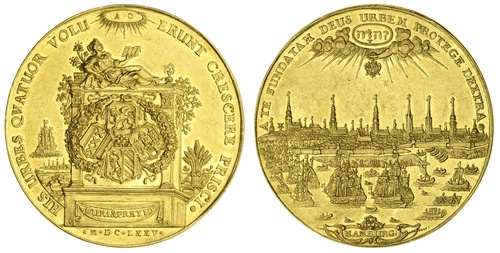
Auction: 344 - The Numismatic Collector's Series Sale at Grand Hyatt, NY INC
Lot: 41
German States, Hamburg, Freie Hansestadt, gold Bank Portugaloser of 10-Ducats, 34.65g, 1675, signed on the reverse
Johann Christoph Reteke (or Retecke), was a medallist at Hamburg c.1664-1720. For thirty years he worked for the Hamburg Species-Bank (1664-93), for which he engraved numerous dies for their spectacular series of Portugalosers. His work was much admired, and he was commissioned to produce medals for Johann Georg II, Prince Elector of Saxony, Prince Elector Palatine Philip William, Duke Christian Albert of Schleswig-Holstein-Gottorp, and Johann Georg II of Anhalt-Dessau. In 1722 he was appointed mint-master at Eutin by Christian August, the Prince-Bishop of Lübeck.
The magnificent Portugalosers produced by Reteke were recognised at the time as pieces of art in their own right. Regarded more as medals than coins, these beautiful and impressive pieces were kept and treasured, mounted as jewellery or set in other grand and decorative objects. As a result many examples have mount marks, signs of polishing, or other wear and tear that such decorative objects naturally acquired over the centuries. Perfect examples such as the two offered here are extremely rare.
Sold for
$24,000




